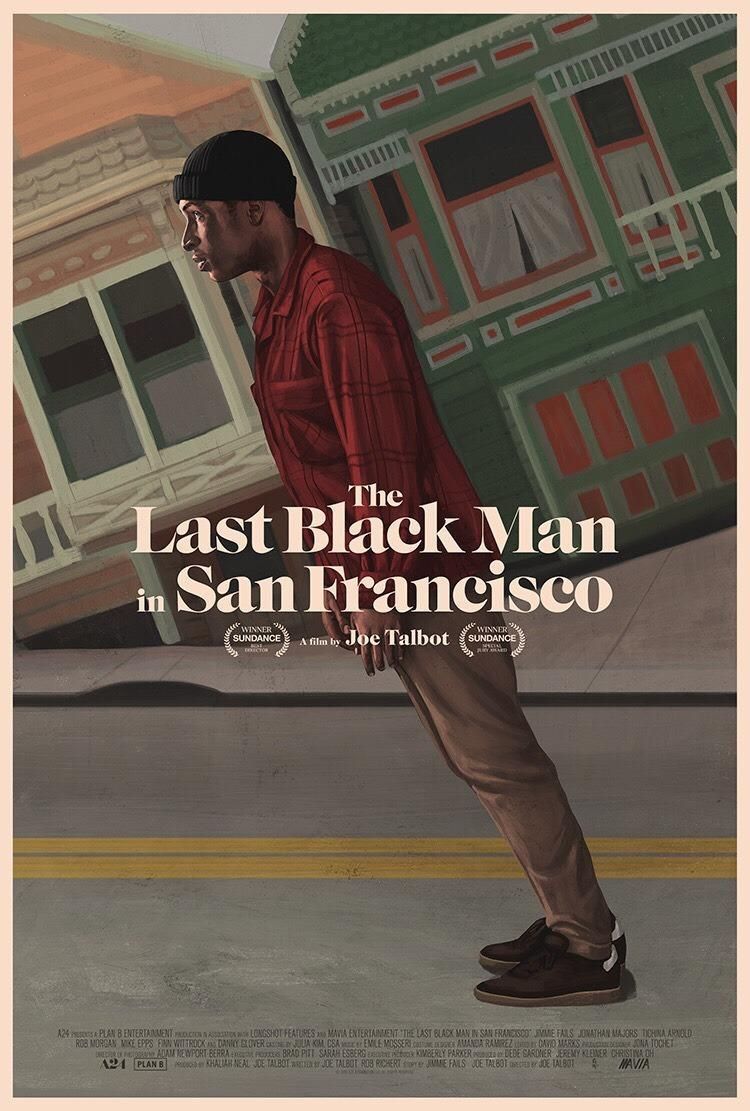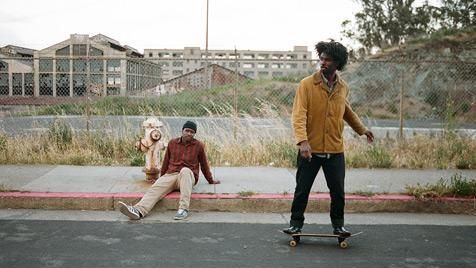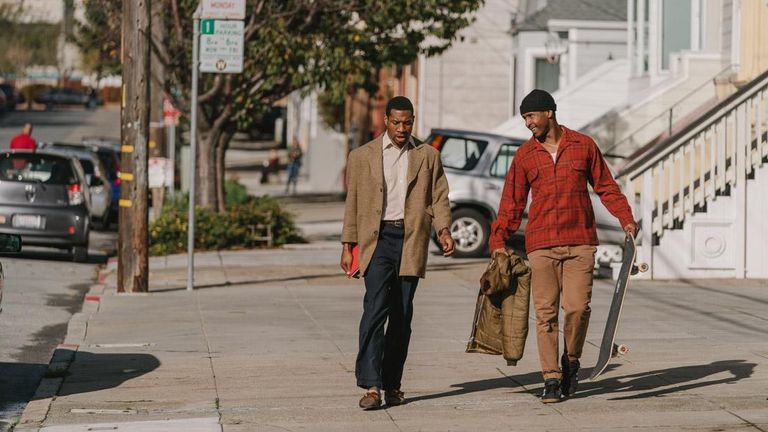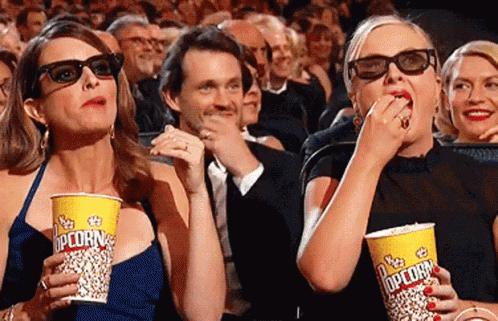
The creative feature film debut of filmmaker Joe Talbot is "Last Black Man." In addition to his longtime buddy Jimmy Fails, who plays the lead character in the movie, he also wrote the screenplay with Rob Richert. In the narrative, Fails portrays a fictionalized version of himself while narrating a fictionalized account of his real upbringing in the constantly evolving city of San Francisco.
A young girl looks up at the camera at the start of the movie. A man in a hazmat suit is seen clearing up rubbish as the focus of her attention emerges. When she starts skipping, the camera tracks her until it finds the street preacher and his two followers. Jimmie (played by Fails) and Montgomery, his best buddy, are waiting for a bus but decide they have waited long enough. After that, the buddies may be seen riding Jimmie's skateboard through the San Francisco neighborhoods toward an unspecified destination. Just a couple of the effective techniques include the use of slow motion and how the camera zooms in on faces.
When the two companions reach the Fillmore District, they make a halt at a specific Victorian house. This is the beginning of what could be said to be the major interaction in the film between Jimmie and this house. We find that his grandfather had built the house in 1946 when Jimmie was a child. The house is currently occupied by an elderly middle-class couple, and the area looks very different from when Jimmie was a child, which raises the question of gentrification.
In the less affluent Bayview-Hunter's Point neighborhood, Mont's grandfather (Danny Glover) shares a small home with Jimmie and Montgomery. However, Jimmie sneaks in to work on the old Victorian whenever the elder couple is gone since he has a desire of owning the home of his youth (although they would rather he didn't). Strong recollections and a deep inner yearning for a dream that might already be out of reach are what fuel this motivation. That connects to one of the many themes that permeate the occasionally disjointed but consistently honest narrative.
In every scene, whether visually or through the individuals who always transmit some aspect of the city's impact, Talbot makes San Francisco itself a crucial part. This is true from the film's opening moments to its heartbreaking last scenes. Talbot and Fails' obvious, organic passion for the Bay Area is visible thanks to Adam Newport-Berra's gorgeous cinematography. Additionally, the operatic score by Emile Mosseri and a few masterfully used cover songs add to the movie's pervasive sense of love and longing.

"Unless you also love it, you're not allowed to hate it." By the time Jimmie says these words, we have already seen him go through difficulty and heartbreak. Even if his city ignores him, he still defends it. Fails speaks truthfully, and his screenplay seldom ever comes off as a performance. It is humorous, sentimental, and heartfelt. Furthermore, Jonathan Majors and the life he gives to Mont, whose own story is both delicate and heartbreaking, deserve a special mention.
The movie "The Last Black Man in San Francisco" has a lot to say regarding a lot of different topics. But humanity, which is its most crucial component, is always kept in mind. The film offers a number of incredibly illuminating viewpoints that open a window into the human experience. And it never loses that impact even during some of its slower periods. The impact of that will sting you for days, adding to the tragedy of the movie's concluding shots.
The Last Black Man in San Francisco
Spanish

El debut cinematográfico creativo del cineasta Joe Talbot es "Last Black Man". Además de su viejo amigo Jimmy Fails, quien interpreta al personaje principal de la película, también escribió el guión con Rob Richert. En la narración, Fails retrata una versión ficticia de sí mismo mientras narra un relato ficticio de su educación real en la ciudad de San Francisco, en constante evolución.
Una niña mira a la cámara al comienzo de la película. Se ve a un hombre con un traje de materiales peligrosos limpiando la basura cuando emerge el foco de su atención. Cuando comienza a saltar, la cámara la rastrea hasta que encuentra al predicador callejero y sus dos seguidores. Jimmie (interpretado por Fails) y Montgomery, su mejor amigo, están esperando un autobús pero deciden que han esperado demasiado. Después de eso, se puede ver a los amigos montando la patineta de Jimmie por los vecindarios de San Francisco hacia un destino no especificado. Solo un par de técnicas efectivas incluyen el uso de cámara lenta y cómo la cámara hace zoom en los rostros.
Cuando los dos compañeros llegan al distrito de Fillmore, hacen una parada en una casa victoriana específica. Este es el comienzo de lo que podría decirse que es la mayor interacción en la película entre Jimmie y esta casa. Encontramos que su abuelo había construido la casa en 1946 cuando Jimmie era un niño. La casa está ocupada actualmente por una pareja de ancianos de clase media, y el área se ve muy diferente a cuando Jimmie era un niño, lo que plantea la cuestión de la gentrificación.
En el vecindario menos próspero de Bayview-Hunter's Point, el abuelo de Mont (Danny Glover) comparte una pequeña casa con Jimmie y Montgomery. Sin embargo, Jimmie se cuela para trabajar en la antigua casa victoriana cada vez que la pareja mayor se va, ya que desea ser dueño de la casa de su juventud (aunque preferirían que no lo fuera). Fuertes recuerdos y un profundo anhelo interior por un sueño que ya podría estar fuera de su alcance son los que alimentan esta motivación. Eso se conecta con uno de los muchos temas que impregnan la narrativa ocasionalmente inconexa pero consistentemente honesta.
En cada escena, ya sea visualmente oa través de los individuos que siempre transmiten algún aspecto del impacto de la ciudad, Talbot hace de San Francisco una parte crucial. Esto es cierto desde los primeros momentos de la película hasta sus desgarradoras últimas escenas. La pasión orgánica y obvia de Talbot y Fails por el Área de la Bahía es visible gracias a la magnífica cinematografía de Adam Newport-Berra. Además, la partitura operativa de Emile Mosseri y algunas versiones de canciones magistralmente utilizadas se suman al sentido generalizado de amor y anhelo de la película.
"A menos que también lo ames, no puedes odiarlo". Cuando Jimmie dice estas palabras, ya lo hemos visto pasar por dificultades y angustias. Incluso si su ciudad lo ignora, todavía la defiende. Fails habla con sinceridad, y su guión rara vez se convierte en una actuación. Es humorístico, sentimental y sincero. Además, Jonathan Majors y la vida que le da a Mont, cuya propia historia es a la vez delicada y desgarradora, merece una mención especial.
La película "El último hombre negro en San Francisco" tiene mucho que decir sobre muchos temas diferentes. Pero la humanidad, que es su componente más crucial, siempre se tiene en cuenta. La película ofrece una serie de puntos de vista increíblemente esclarecedores que abren una ventana a la experiencia humana. Y nunca pierde ese impacto, incluso durante algunos de sus períodos más lentos. El impacto de eso te dolerá durante días, sumándose a la tragedia de las tomas finales de la película.



Congratulations, your post has been curated by @r2cornell-curate. Also, find us on Discord
Felicitaciones, su publication ha sido votado por @r2cornell-curate. También, encuéntranos en Discord